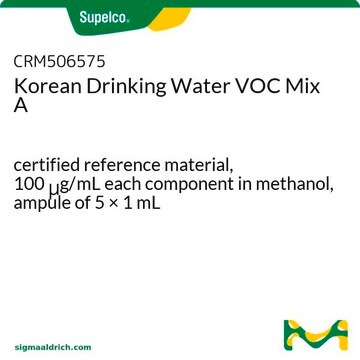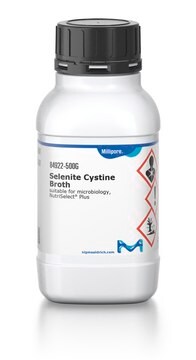51490
Hektoen Enteric Agar
suitable for microbiology, NutriSelect® Plus
About This Item
Recommended Products
sterility
non-sterile
Quality Level
form
powder
shelf life
limited shelf life, expiry date on the label
composition
acid fuchsin, 0.1 g/L
agar, 15.0 g/L
ammonium ferric citrate, 1.5 g/L
bile salts, 9 g/L
bromothymol blue, 0.065 g/L
lactose, 12 g/L
mixed peptone, 12 g/L
salicin, 2 g/L
sodium chloride, 5 g/L
sodium thiosulfate, 5 g/L
sucrose, 12 g/L
yeast extract, 3 g/L
manufacturer/tradename
NutriSelect® Plus
technique(s)
microbiological culture: suitable
final pH
7.5±0.2 (25 °C)
application(s)
clinical testing
environmental
food and beverages
water monitoring
microbiology
suitability
selective and differential for Salmonella spp.
selective and differential for Shigella spp.
selective and differential for bacteria (General Media)
Application
Preparation Note
Other Notes
Footnote
The designations basic, plus, or prime are added to indicate the quality control level, from basic quality control to standard QC plus to prime for full regulatory compliance.
Legal Information
Signal Word
Warning
Hazard Statements
Precautionary Statements
Hazard Classifications
Skin Sens. 1
Storage Class Code
11 - Combustible Solids
WGK
WGK 3
Flash Point(F)
Not applicable
Flash Point(C)
Not applicable
Personal Protective Equipment
Regulatory Listings
Regulatory Listings are mainly provided for chemical products. Only limited information can be provided here for non-chemical products. No entry means none of the components are listed. It is the user’s obligation to ensure the safe and legal use of the product.
ISHL Indicated Name
Substances Subject to be Indicated Names
ISHL Notified Names
Substances Subject to be Notified Names
JAN Code
51490-VAR:
51490-100G:
51490-BULK:
51490-500G:
Choose from one of the most recent versions:
Already Own This Product?
Find documentation for the products that you have recently purchased in the Document Library.
Customers Also Viewed
Articles
Salmonella, with 2,300+ serotypes, causes half of food-borne illnesses, often from dairy, poultry, and eggs.
Our team of scientists has experience in all areas of research including Life Science, Material Science, Chemical Synthesis, Chromatography, Analytical and many others.
Contact Technical Service










